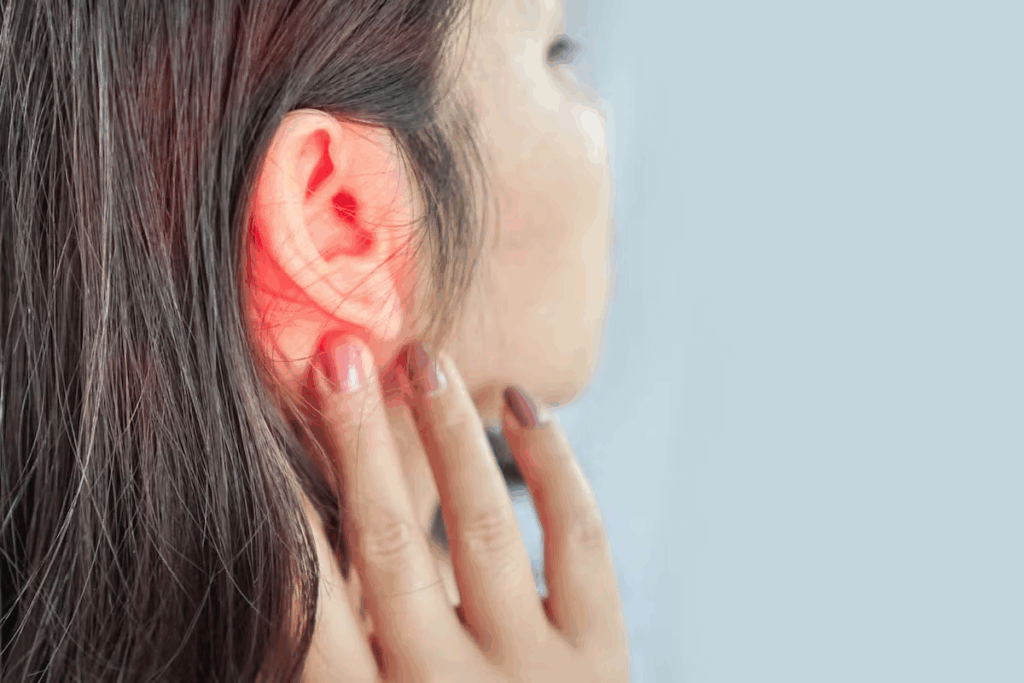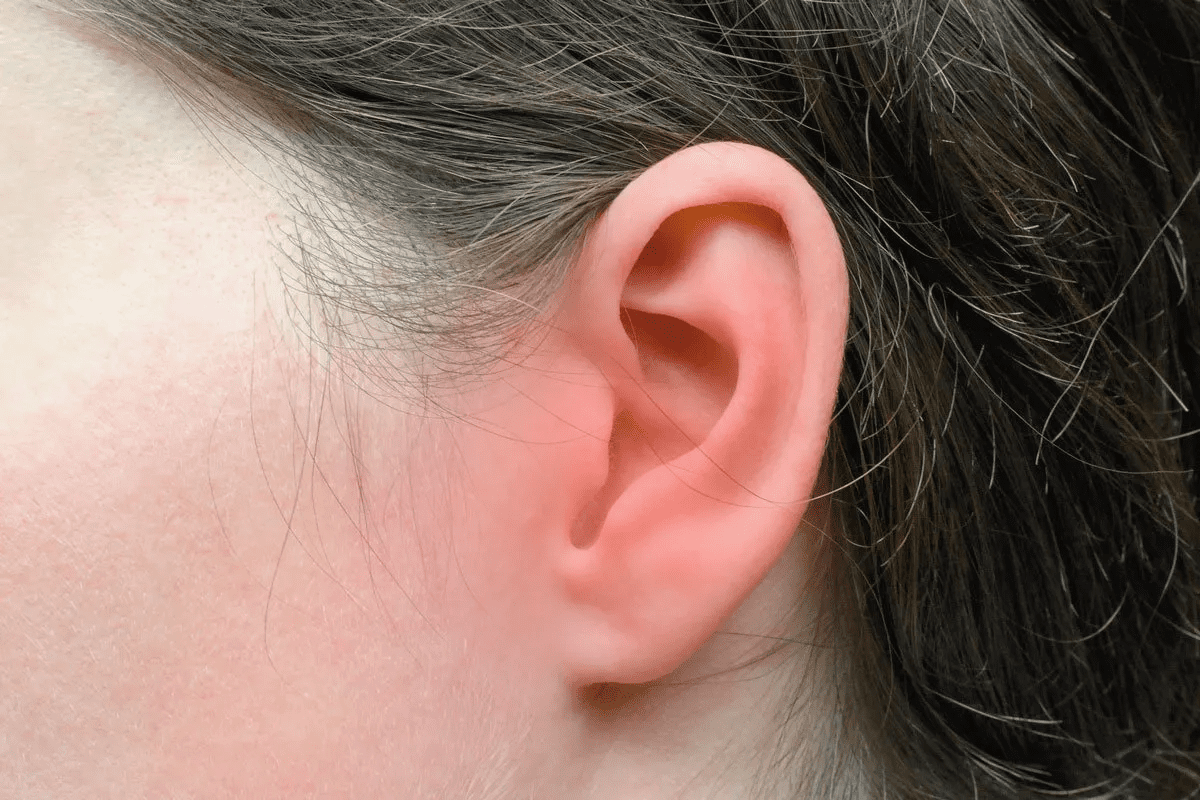
Millions of people get ear infections every year. They often feel ear pain and also headaches and nausea. These symptoms can really mess up their day.
At Liv Hospital, we know that ear infections can cause headaches and nausea. These symptoms happen because of the infection in the ear. It’s important to understand this connection to treat it right.
We will look into how ear infections link to headaches and nausea. We’ll talk about what causes these symptoms and how to treat them.
Does ear infection cause head pain and nausea? Yes, pressure buildup and vertigo are often the culprits behind these symptoms.

It’s important to know how ear infections can cause head pain. This knowledge helps in treating the issue effectively. Ear infections can cause a lot of discomfort, including headaches, because of the inflammation and fluid buildup.
Ear infections can lead to headaches because of their close location to the brain. The trigeminal nerve is key in connecting ear pain to headaches.
Inflammation and fluid buildup in the ear can cause pressure. This pressure can spread to the head, causing headaches. Studies show that severe headaches often come with inner ear infections. These headaches can also include temporary hearing loss, balance problems, and nausea with vomiting.
Ear Infection Type | Common Symptoms | Associated Headache Characteristics |
Outer Ear Infection | Ear pain, itching, discharge | Mild to moderate headache, often localized |
Middle Ear Infection | Hearing loss, ear pain, fever | Moderate to severe headache, sometimes with ear pressure |
Inner Ear Infection | Vertigo, nausea, hearing loss | Severe headache, often with balance disturbances |

The ear is a complex structure, and infections can occur in different parts, leading to various conditions. Ear infections are typically classified based on the part of the ear they affect. Understanding these different types is key for proper diagnosis and treatment.
Outer ear infections, also known as otitis externa, affect the outer ear canal. This condition is often caused by bacterial or fungal infections. It can happen due to moisture in the ear canal, trauma, or irritation from objects inserted into the ear.
Symptoms may include pain, itching, redness, and discharge. Proper ear hygiene and avoiding insertion of objects into the ear canal can help prevent otitis externa.
Middle ear infections, or otitis media, involve the middle ear space behind the eardrum. This type of infection is more common in children and can be caused by bacteria or viruses. Symptoms may include ear pain, fever, hearing loss, and irritability.
Prompt treatment is essential to prevent complications such as eardrum perforation or mastoiditis.
Inner ear infections, such as labyrinthitis and vestibular neuritis, affect the inner ear structures responsible for balance and hearing. Labyrinthitis is an inflammation of the inner ear that can cause vertigo, hearing loss, and nausea. Vestibular neuritis is an inflammation of the vestibular nerve, leading to severe vertigo.
These conditions can significantly impact an individual’s balance and equilibrium, requiring careful management.
Inner ear infections like labyrinthitis and vestibular neuritis commonly present with nausea and vomiting as accompanying symptoms due to the disturbance of the vestibular system. Understanding the specific type of ear infection is key for targeted treatment and alleviating symptoms.
Medical studies have looked into the link between ear infections and head pain. They found a strong connection. Ear infections, mainly those in the inner ear, can cause inflammation and pressure. This can lead to headaches.
Research shows ear infections can cause head pain. The inflammation and pressure changes from these infections can lead to headaches. For example, inner ear infections like labyrinthitis can cause vertigo and headaches.
Key findings from clinical research include:
Patient stories and case studies show the complex link between ear infections and head pain. These stories show how symptoms can vary from person to person.
A case study on a patient with labyrinthitis showed severe headaches and vertigo. These symptoms went away after treating the infection. Such cases stress the need for accurate diagnosis and treatment.
Patient experiences highlight the importance of personalized care. Symptoms of ear infections can differ greatly from one person to another.
Understanding the trigeminal nerve is key to seeing how ear infections lead to headaches. This nerve is complex and carries sensory info from the face, including the ear, to the brain. It’s vital in linking ear pain to headaches.
The trigeminal nerve is one of the twelve cranial nerves. It has three main branches: the ophthalmic, maxillary, and mandibular. These branches help us feel sensations on our face and control chewing. The trigeminal nerve’s extensive reach includes areas around the ear, making it a key player in transmitting pain signals.
Pain from an ear infection can travel through the trigeminal nerve to the brain. There, it’s seen as a headache. This happens when nerve endings in the ear send signals through the trigeminal nerve pathways to the central nervous system. The brain then interprets these signals, often causing headache.
The trigeminal nerve’s role in pain transmission is why it’s so important in treating headaches from ear infections. By knowing how pain signals move from the ear to the head, doctors can find better ways to treat these headaches.
The vestibular system in the inner ear is key for balance. When it’s disrupted by an ear infection, it can lead to nausea and vomiting. This system helps us sense head movements and changes, keeping us steady.
The inner ear has the vestibular apparatus, with parts like the otolith organs and semicircular canals. These are filled with fluid and lined with hair cells. They detect movement and head changes, helping us stay balanced.
An ear infection can harm this system. Conditions like labyrinthitis and vestibular neuritis can cause inflammation and damage. This disrupts the normal signals to the brain.
Disruption of the vestibular system can result in a range of symptoms, including:
An infection in the inner ear messes with the vestibular system’s function. This can cause a mismatch between what the body feels and what the brain expects. Symptoms like nausea and vomiting can follow.
Labyrinthitis, for instance, can cause inflammation. This leads to abnormal signals from the sensory hair cells to the brain. It makes it hard for the body to balance, leading to severe vertigo, nausea, and vomiting.
Understanding how inner ear issues affect balance is key. It helps healthcare providers find the right treatments. They can help manage symptoms like nausea and vomiting caused by ear infections.
It’s important to know the signs of an ear infection. It can cause ear pain, headaches, and other symptoms. Being aware of these signs helps in getting the right treatment quickly.
Ear infections can cause more than just ear pain. They can also lead to headaches and nausea. Symptoms like ear pain, fever, and hearing loss are common. Sometimes, people may also feel nauseous or vomit.
Ear infections often show symptoms beyond just ear pain. For example, middle ear infections can cause headaches. Knowing these patterns helps in diagnosing and treating ear infections well.
Ear infection symptoms differ between kids and adults. Kids might seem irritable, have a fever, or pull at their ears. Adults usually feel ear pain, hearing loss, and sometimes headaches.
In kids, ear infections can also cause loss of appetite and trouble sleeping. Adults might feel like their ears are full or hear ringing sounds. They also might experience ear pain and headaches.
Some ear infections need urgent medical care. Look out for severe ear pain, high fever, ear discharge, and significant hearing loss. Also, if headaches are very bad, don’t go away, or come with dizziness or confusion, see a doctor right away.
If symptoms get worse or don’t get better with treatment, seek medical help. Early treatment can stop complications and help people feel better sooner.
Figuring out if symptoms are from an ear infection or something else needs careful checking. Getting the right diagnosis is key for good treatment. Many conditions can look like ear infections.
Differential diagnosis means looking at many possible reasons for ear symptoms. We check the patient’s health history, how they feel, and sometimes tests to find the real cause. Ear infections aren’t the only thing that can hurt or feel off in the ear. Other things like TMJ disorders, Eustachian tube problems, mastoiditis, and sinusitis can also cause pain or discomfort.
Doing a detailed differential diagnosis helps us figure out what’s really going on and find the right diagnosis.
There are many tests and exams that help us diagnose ear infections and tell them apart from other issues. These include:
These tests give us important info that helps us decide on the best treatment.
Many conditions can look like ear infections, making it hard to diagnose. For example:
“The symptoms of ear infections can be similar to those of other conditions, such as allergies or sinus infections, which can complicate the diagnosis process.”
Some of these conditions include:
Condition | Similar Symptoms |
TMJ disorders | Ear pain, facial pain |
Eustachian tube dysfunction | Ear fullness, hearing changes |
Sinusitis | Ear pain, pressure, congestion |
Knowing about these look-alikes helps us do a better job of figuring out what’s really going on.
Dealing with ear infections means tackling the infection and its symptoms. We’ll look at treatments like medicine, home remedies, and self-care.
Antibiotics are key for bacterial ear infections. They fight the infection. Pain relievers like acetaminophen or ibuprofen ease ear pain and headaches. Sometimes, antiemetic medications help with nausea and vomiting.
Medication Type | Purpose | Examples |
Antibiotics | Treat bacterial infections | Amoxicillin, Ciprofloxacin |
Pain Relievers | Alleviate ear pain and headaches | Acetaminophen, Ibuprofen |
Antiemetics | Manage nausea and vomiting | Ondansetron, Metoclopramide |
Home remedies and self-care can help too. A warm compress on the ear eases pain. Sleeping with your head up also helps. Drinking water and resting are important for recovery.
Managing nausea means changing what you eat and using medicine. Eat small meals and avoid spicy or fatty foods. Sometimes, antiemetic medications are needed to stop nausea and vomiting.
With a mix of medicine, home remedies, and self-care, you can manage ear infections. This helps with headaches and nausea too.
Ear infections can lead to serious problems if not treated. These issues can be short-term or long-term, affecting a person’s life quality.
Untreated ear infections can cause hearing loss. This can happen because of fluid in the middle ear or damage to the inner ear. Another problem is mastoiditis, an infection of the mastoid bone.
Mastoiditis can make you feel feverish, in pain, and swollen behind the ear. In some cases, it can lead to labyrinthitis. This is an inner ear infection causing dizziness and balance issues.
Recurring ear infections can lead to long-term health problems. Chronic hearing loss can make it hard to communicate. Also, it can cause eustachian tube dysfunction.
This dysfunction leads to ongoing ear pressure and hearing problems. In rare cases, untreated infections can spread to the brain. This can cause meningitis or a brain abscess, which are emergencies.
Knowing the risks of untreated ear infections is key. If symptoms don’t go away or get worse, see a doctor. Early treatment can prevent many complications and improve outcomes.
Knowing how long it takes to get better from an ear infection is key. It helps us know when to see a doctor again. Symptoms like headaches and nausea can last longer, depending on the infection’s severity and treatment success.
Most people start feeling better in a few days after treatment starts. But, it can take longer for all symptoms to go away. Here’s what we can expect:
Several things can change how fast symptoms go away. These include:
Factor | Impact on Healing Time |
Severity of Infection | More severe infections may take longer to heal. |
Effectiveness of Treatment | Good and timely treatment can help symptoms go away faster. |
Overall Health | People with health issues may recover slower. |
While recovery times can vary, some signs mean you should see a doctor again. Look out for:
Knowing what to expect and how to handle it can help you through the recovery. It also tells you when to get more help.
Knowing how to prevent ear infections is key to keeping your ears healthy. It helps avoid headaches and nausea too. By making lifestyle changes and watching out for environmental factors, you can lower your risk of ear infections.
Changing your lifestyle can help a lot in preventing ear infections. Practicing good hygiene is a must. Washing your hands often can stop viruses and bacteria from causing infections.
Also, staying away from secondhand smoke is important. Smoke can irritate the Eustachian tube and make infections more likely.
Managing allergies well is also key. Allergies can mess with the Eustachian tube, raising the risk of infections. Using allergy management techniques like avoiding allergens or using nasal sprays can help.
Being mindful of your environment can also help prevent ear infections. For example, keeping your ears dry when bathing or swimming can stop water from getting in. Using earplugs while swimming is a good idea.
Keeping your home clean and well-ventilated is also important. This helps keep your ears healthy.
Prevention Strategy | Description | Benefit |
Good Hygiene Practices | Regular handwashing | Reduces transmission of infections |
Avoiding Secondhand Smoke | Reducing exposure to smoke | Decreases irritation to the Eustachian tube |
Allergy Management | Using antihistamines or nasal sprays | Mitigates Eustachian tube dysfunction |
If you often get ear infections, there are extra steps you can take. Talking to a healthcare provider to find out why you get infections is a good idea. They might suggest preventive antibiotics during high-risk times, like when you have a cold.
“Prevention is key, specially for those prone to recurrent ear infections. Understanding and implementing preventive measures can significantly improve quality of life.”
Also, if you get ear infections a lot, seeing an ear, nose, and throat (ENT) specialist regularly is a good idea. They can check your ears and fix any problems quickly.
Ear infections are a big health problem that can lead to serious issues if not treated right. We’ve looked at how ear infections can cause headaches and nausea, affecting a person’s life quality. It’s key to understand the link between these symptoms and how to treat them well.
By going over the main points, we’ve seen ear infections can cause headaches because of pressure and swelling. Nausea happens because of problems in the balance system. It’s important to know the signs and get medical help when needed to avoid health risks.
We stress the need for preventive steps, like changing your lifestyle and the environment around you. By being proactive, people can lower the chance of getting ear infections. This helps avoid headaches and nausea, making life better overall.
Yes, ear infections can cause headaches. This happens because of the inflammation and fluid buildup. It can also stimulate the trigeminal nerve, leading to pain in the head.
Yes, inner ear infections like labyrinthitis and vestibular neuritis can cause nausea and vomiting. This is because they disrupt the vestibular system.
Ear infections can cause headaches in both children and adults. But, children might be more irritable, while adults might feel more pain in specific areas.
Doctors use a few methods to diagnose ear infections. They look at your medical history and do a physical exam. They might also use tests like tympanometry or imaging studies.
Some symptoms can be managed at home with pain relievers and warm compresses. But, it’s important to see a doctor for proper diagnosis and treatment.
Untreated ear infections can lead to serious problems. These include hearing loss, mastoiditis, and even infections that spread to other parts of the head.
The time it takes for symptoms to go away depends on the infection’s type and severity. It also depends on how well the treatment works. Symptoms usually get better as the infection clears.
Yes, you can prevent ear infections. Practice good hygiene, avoid smoke, manage allergies, and get vaccinated against flu and pneumococcus.
Most ear infections are treated without lasting effects. But, recurring or untreated infections can lead to chronic conditions like hearing loss or tinnitus.
Yes, ear infections can cause headaches on the same side as the infected ear. This is due to the localized inflammation and pain transmission through the trigeminal nerve.
Not all ear infections cause nausea. But, inner ear infections are more likely to cause it. This is because they affect the vestibular system.
Yes, some ear infections, like those involving the inner ear, can cause severe headaches. This is due to the inflammation and pressure changes they cause.
MedlinePlus. (n.d.). Tonsillectomy – adult. Retrieved from https://medlineplus.gov/ency/article/002930.htm
Subscribe to our e-newsletter to stay informed about the latest innovations in the world of health and exclusive offers!
WhatsApp us